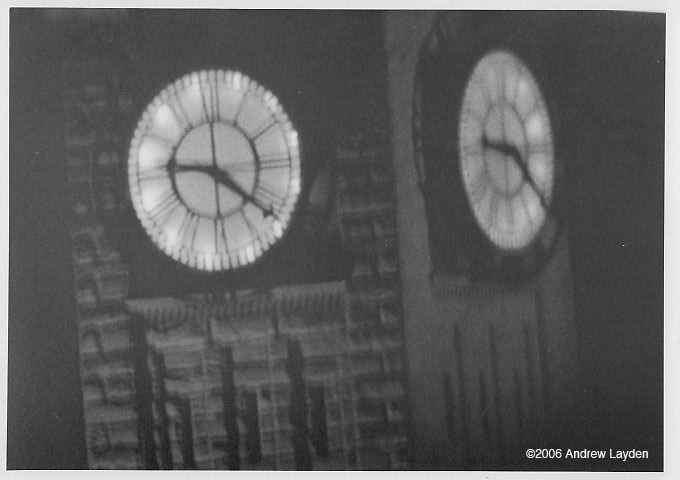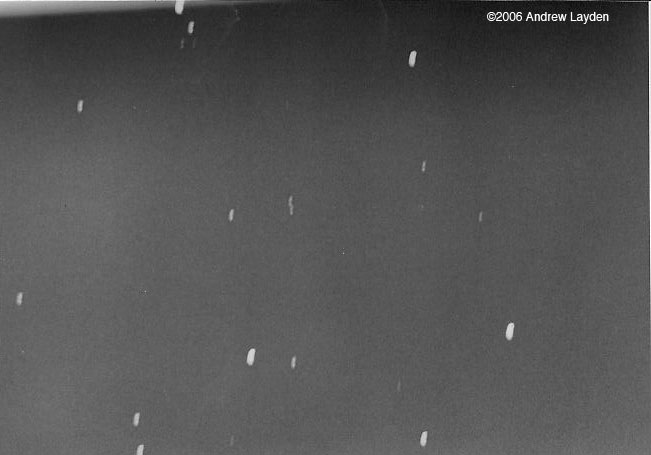
I. Our first image was of the Wood County Court House clock tower. I didn't write down the exposure time, but it was short (1/30 sec?). The image is blurred mainly by imperfect focus of the darkroom enlarger, though some blurriness is apparent on the negative as well, due either to poor focus or poor seeing (looking horizontally across warm rooftops in Bowling Green).

The theoretical scale of our 2000 mm focal length C8 telescopes is 103 "/mm, giving a field of view of 43 x 60 arcmin on a 35 mm film negative. The enlargement here shows a fraction of the entire negative, perhaps 35 x 50 arcmin. I measured the diameter of the clock face (from VI to XII, so not foreshortened) on the negative to be 9 mm, so the angular diameter of the clock face as seen from our location was 930 arcsec. If I know the distance between the clock tower and the telescope, I can use the Small Angle Formula to convert this angular diameter into a true physical diameter. Based on a map from maps.google.com I estimated the distance to be 800 m, so p = A * d / 206265 = 3.6 m (about 12 feet) is my estimate for the diameter of the clock face. Remote sensing at its finest!
II. Our second image was of the Pleiades (M45) open cluster. This print was made from a negative exposed for 40 sec. Trailing due to clockdrive inconsistencies or vibration of the pedestal mount are noticable. Variation in the level of the sky background is probably due to uneven exposure to the developer solution in the darkroom (better agitation needed?).

The field of view of the print is much smaller than the 110 arcmin diameter of the cluster listed in Norton's Star Atlas (2004), and I have not been able to identify the specific stars in the image using charts or images. I was not careful to align the camera with the cardinal directions (NSEW) of the telescope, so the rotation is not known (in the future, I would remember to rotate the camera to align), and this further complicated identifying stars in the field. A wide range of stellar magnitudes is evident in the image -- had I been able to identify stars I could have used their published magnitudes to discuss the limiting magnitude in the image. This image was part of a sequence of three, having exposure times of 10, 40, and 160 sec. The 160 sec exposure showed fainter stars, but the sky background level was higher due to light pollution in our small city.
M45 is a nearby open cluster. Its proximity to the Sun (d = 440 ly) contributes to its large apparent angular size (110 armin diameter) and the apparent brightness of its stars. The ~6 naked-eye stars are the brightest in the cluster; over 500 fainter stars are known, including main-sequence and brown dwarf stars. The color-magnitude diagram of M45 suggests the stars in this cluster formed about 100 million years ago -- quite young compared to the Sun (4.6 billion years old) and the ancient globular clusters (~12 billion years old). More information about M45, from modern observations to its rich history in mythology, can be found at the SEDS website.
1. The observing location, mode, camera, film type and other particulars are well documented. Shame on me for not knowing the exposure time of the clocktower image!
2. I critically discuss the strengths and weaknesses of the images.
3. When possible, I do analysis on the image using the equations we discussed in class (e.g., scale, field of view, small angle formula). Getting quantitative information out of your images bridges the gap between art and science and increases the relevance of your project to our class. If I could identify stars in the Pleiades image, I could calculate the (projected) distances between certain stars, or do the magnitude analysis described above.
4. I don't have enough images to make my study systematic. If I had several open cluster images, I could compare and contrast their properties (not only appearance, but calculated values like typical distances between stars, or physical diameters of the clusters). If I took images of M45 using different observing modes (tripod, zoom lens on piggyback, 8-in prime focus and 0.5-m prime focus), I could compare and contrast the views from the different modes.
5. I refer to outside material and cite my sources. I link to websites I used, and refer to the title and publication date of Norton's Star Atlas. A bibliography of books used might be appropriate; since Norton's was our textbook I didn't feel obliged.
6. On the Pleiades discussion, I note what I learned and would do differently next time (better agitation when developing; align the camera with NSEW directions on the telescope). Learn from the past to plan for the future.
7) I'd give this project a grade of B. It has two images that are photos that were developed and printed using our darkroom equipment, and that is between the benchmarks for a C and an A in the requirements (well, really I'd want 2 pictures of the SKY, but...). The images are OK quality (could be better focus), so that detracts a bit. The discussion is quite good, bringing in a lot of quantitative analysis that applies the equations we developed in class to clarify and elucidate the images. If I'd been able to figure out what part of the Pleiades I was looking at and identify the stars (Alcyone, etc), it would have been even better.